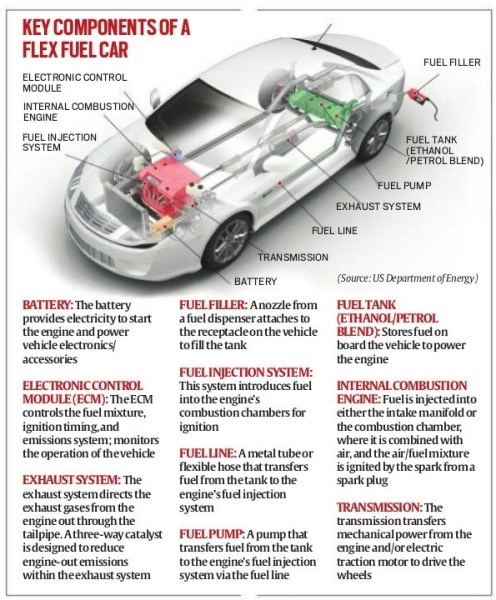Toyota last week unveiled a prototype of the Innova Hycross with a flex-fuel
hybrid powertrain, its first car in India with this option, and one that the Japanese
carmaker claims is the world’s first BS6 Stage II-compliant flex-fuel vehicle. Toyota
had displayed an imported Corolla flex-fuel hybrid sedan as a pilot project late last
year. The pilot was initiated as part of a government-led push to commercially
deploy this technology, which is already in use in markets such as Brazil, Canada,
and the United States.
Hycross prototype
The Hycross flex-fuel prototype has a 2-litre Atkinson Cycle petrol engine coupled
with an electric motor, the same as in the hybrid version of the standard Hycross.
Toyota claims the prototype can run on petrol with more than 20% ethanol
blending that is currently mandated in India, and that its performance would be at
par with the standard Hycross hybrid, even with ethanol-blended petrol.
Also, the company says, it will achieve low carbon emissions “on a comprehensive
well-to-wheel basis”. Like the standard strong hybrid variant, the Hycross flex-fuel
prototype would run 60% of the time in the electric vehicle mode using energy
stored in the battery pack.
For now, multiple units of the flex-fuel prototype will be tested in India. The next
steps include further finer calibration, homologation (process of certifying that a
vehicle is roadworthy), and certification. Flex-fuel technology A flex-fuel vehicle
typically has an internal combustion engine (ICE), but unlike a regular petrol
vehicle, it can run on more than one type of fuel, or a mixture of these fuels. The
most common versions use a blend of petrol and ethanol or methanol. Flex-fuel
vehicles such as the prototype Hycross can run on blends of ethanol that are far
higher than the current standard 20% mix (E20).
This is made possible by equipping the engine with a fuel mix sensor and an engine
control module (ECM) programming that senses and automatically adjusts for any
ratio of designated fuels. Union Minister for Road Transport and Highways Nitin
Gadkari had told The Indian Express earlier that the flex engines push is part of the
broader strategy to cut dependence on imported crude in the medium-to-long run.
How these cars work
Most components in a flex fuel vehicle are the same as those in petrol-only cars. But
some special ethanol-compatible components are required to adjust to the different
chemical properties and energy content in ethanol/ methanol, such as modifications
to the fuel pump and fuel injection system
The ECM is also calibrated to accommodate the higher oxygen content of ethanol.
The hybrid engine of the type used in the Toyota Hycross would have separate
spark plugs, piston ring tops, and valves to render them more corrosion-resistant,
and a modified catalyst in the exhaust system to lower hydrocarbon emissions.
The vehicle’s fuel filter and fuel lines have also been tweaked. According to IHS
Markit, as of 2018, there were more than 21 million flex-fuel vehicles in the US, but
Brazil was the biggest market and leader in this segment.

Flex pros and cons
So, while fuel economy is generally lower with increased levels of ethanol (engines
are optimised for petrol), many flex fuel vehicles have improved acceleration performance when operating on higher ethanol blends. Another problem with ethanol blending is that source crops such as sugarcane are usually very waterintensive. According to a NITI Aayog report, in 2019-20, more than 90% of the ethanol produced in the country came from sugarcane, which is also a politically important crop in states such as Maharashtra and Uttar Pradesh.
The National Biofuel Policy 2018 envisages a 2025 target of 20% blending. Countries
such as Brazil can be flexible on the degree of the mix depending on crude prices,
varying it when energy prices rise like they did after the Ukraine war — the
precondition being that the vehicular fleet has been equipped to adjust to this
varying fuel mix.
In Brazil, nearly all cars are required to be able to handle fuel blends with a
minimum of 22% ethanol, and the state-owned oil company Petrobras is mandated
to buy ethanol and dispense the mix at retail pumps. As a result, almost no light
vehicle in Brazil runs on pure petrol. There is also a government subsidy to narrow
The ethanol mix in petrol in India went up from 1.53% in 2013-14 to 11.5% in
March 2023. This has helped cut the oil import bill by an estimated Rs 41,500 crore
in the last eight years. In 2020-21, ethanol blending enabled a reduction of 26
million barrels of petrol, resulting in savings of Rs 10,000 crore, according to official
estimates. The expected implementation of E20 by April 2025 is estimated to result
in annual savings of Rs 35,000 crore in India’s oil import bill. To overcome the
challenges of lower fuel efficiency of flex-fuel vehicles, electrified flex-fuel vehicles
are being introduced, which offer the advantages of both a flex-fuel engine and an
electric powertrain, as in the case with the Hycross prototype.





